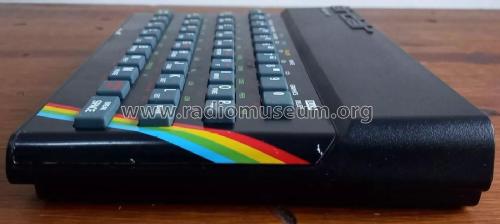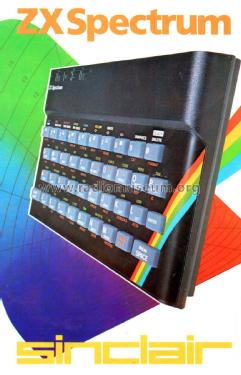ZX Spectrum 8-Bit Home Computer
Sinclair Radionics Ltd.; St. Ives (Cambridge)
- Country
- Great Britain (UK)
- Manufacturer / Brand
- Sinclair Radionics Ltd.; St. Ives (Cambridge)
- Year
- 1982 ?
- Category
- Signal Processing and Computing
- Radiomuseum.org ID
- 358864
- Number of Transistors
- Semiconductors present.
- Semiconductors
- Wave bands
- - without
- Power type and voltage
- Batteries / addl. power jack / AA: 2 x 1.5, 5 Volt
- Loudspeaker
- - For headphones or amp.
- Material
- Plastics (no bakelite or catalin)
- from Radiomuseum.org
- Model: ZX Spectrum 8-Bit Home Computer - Sinclair Radionics Ltd.; St.
- Shape
- Portable set > 8 inch (also usable without mains)
- Dimensions (WHD)
- 233 x 30 x 144 mm / 9.2 x 1.2 x 5.7 inch
- Notes
-
The Sinclair ZX Spectrum, an iconic 8-bit home computer, was developed by Sinclair Research and launched in the UK on April 23, 1982. It succeeded the highly successful ZX81, released just a year earlier.
Development
The ZX Spectrum's development began in September 1981, mere months after the ZX81's release. A team of 20 engineers worked diligently in a small Cambridge office to bring the project to fruition. Richard Altwasser spearheaded the hardware design, which included the innovative ULA (uncommitted logic array) integrated circuit. Steve Vickers from Nine Tiles was responsible for creating the software and writing the manual.Key Features
- The ZX Spectrum boasted several impressive features for its time:
- Zilog Z80A CPU clocked at 3.5 MHz
- 16KB of ROM and either 16KB or 48KB of RAM
- Resolution of 256 x 192 pixels
- Distinctive rubber keyboard
- 15-color palette
- Use of a tape recorder for loading data and applications
Market Impact
The ZX Spectrum was an immediate success, selling nearly a million units within its first year on the market. It effectively ushered in the home computer era, seamlessly blending entertainment with practical applications. The computer's affordability played a crucial role in its popularity, with the 16KB model priced at around 125 pounds and the 48KB model at 175 pounds.Notable Peripherals
The ZX Spectrum ecosystem was enriched by a variety of peripherals:
- Joysticks and interfaces (e.g., Kempston Interface)
- Printers, including the dedicated ZX Printer
- Storage devices such as the Sinclair Microdrive and external disk drives
- The Rotronics Wafadrive, offers larger storage capacities
- Interface 1 for RS-232 connectivity and peripheral expansion
- Modems for communication and data transfer
- Sound units like the Currah MicroSpeech
- Keyboard upgrades (e.g., DK'Tronics and SAGA 1 Emperor)
- Beta Disk Interface for connecting disk drives
- Light pens for direct screen interaction
- RAM Turbo Interface for additional functionality
Later Models
Sinclair continued to innovate with subsequent models:
- ZX Spectrum+ (1984)
- ZX Spectrum 128 (1985)
- In 1986, Amstrad acquired the Spectrum line and released:
- ZX Spectrum +2 and +2A (with built-in tape drive)
- ZX Spectrum +3 (with built-in 3" disk drive)
Legacy
The ZX Spectrum left an indelible mark on computing history:- Over 24,000 software titles were released for the platform
- Approximately 5 million units were sold worldwide
- It played a crucial role in fostering the development of software companies
- The computer's success contributed to Clive Sinclair receiving a knighthood
The Sinclair ZX Spectrum remains a beloved piece of computing history. It is celebrated for bringing affordable home computing to the masses and inspiring a generation of programmers and enthusiasts.
- Price in first year of sale
- 125.00 GB £
- Mentioned in
- - - Manufacturers Literature
- Author
- Model page created by Gary Cowans. See "Data change" for further contributors.
- Other Models
-
Here you find 42 models, 40 with images and 19 with schematics for wireless sets etc. In French: TSF for Télégraphie sans fil.
All listed radios etc. from Sinclair Radionics Ltd.; St. Ives (Cambridge)






